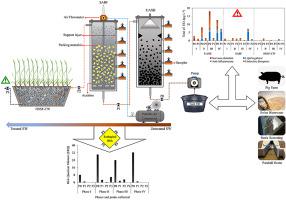Chemosphere ( IF 8.8 ) Pub Date : 2020-07-03 , DOI: 10.1016/j.chemosphere.2020.127516 Jacineumo Falcão de Oliveira 1 , Ronaldo Fia 1 , Fernando Neris Rodrigues 2 , Fátima Resende Luiz Fia 1 , Mateus Pimentel de Matos 1 , Luciene Alves Batista Siniscalchi 1 , Ananda Lima Sanson 3

|
This study aims to evaluate the dynamics and their ecological risks for aquatic species of lipid regulator, nervous stimulant, anti-inflammatory and endocrine disrupters in an upflow anaerobic sludge blanket (UASB), submerged aerated biological filters (SABF) and horizontal subsurface flow constructed wetland (HSSF-CW) reactors that treat swine wastewater. Four organic loads of swine wastewater (SW) were used according to changing the chemical oxygen demand. 13 contaminants were quantified, standing out the endocrine disruptors, lipid regulator and anti-inflammatory. In phase III, 8318.4 ng L−1 of 4-ocylphenol was found at the influent of the UASB reactor and removal from 1877.1 to 13.7 ng L−1 in the bisphenol A system. With the maximum organic load, there was a reduction among all the treatment units, with concentrations between 1877.1 and 13.7 ng L−1 of bisphenol A and had naproxen removal of 94.5% and 2,7 ng L−1 after treating phases II and III. It was found that 24.6% of the contaminants presented a high ecological risk, with maximum values of 27.4 (4-nonylphenol, phase II), 24.6 and 5.9 (17β-estradiol, phase IV and I, respectively), 13.4 (4-ocylphenol, phase III) and 4.4 (estrone, phase IV) in the influent system. The reduction of ecological risk potentials was optimized by SABF and HSSF-CW. The effect oxygen availability and microbiological activities optimized the reduction of ecological risks on zebrafish (Danio rerio) and cnidarian (Hydra attenuata) species, moreover, the reduction of mass flows and ecological risks of the emerging contaminants are associated with the use of biological reactors in series and organic stabilizations.
中文翻译:

集成生物反应器处理过的猪废水不同有机负荷中新兴污染物的量化,去除和潜在的生态风险。
这项研究旨在评估上流厌氧污泥层(UASB),水下曝气生物滤池(SABF)和水平地下流人工湿地中脂质调节剂,神经兴奋剂,消炎和内分泌干扰物的水生物种的动力学及其生态风险。 (HSSF-CW)处理猪废水的反应器。根据化学需氧量的变化,使用了四种有机负荷的猪废水。量化了13种污染物,突出了内分泌干扰物,脂质调节剂和抗炎药。在阶段III中,在UASB反应器的进水处发现8318.4 ng L -1的4-辛基苯酚,并从1877.1 ng L -1去除在双酚A系统中。在最大有机负荷下,所有处理单元之间的浓度都有所降低,双酚A的浓度在1877.1和13.7 ng L -1之间,处理第二阶段和第三阶段后萘普生的去除率分别为94.5%和2.7 ng L -1。。发现24.6%的污染物具有较高的生态风险,最大值分别为27.4(4-壬基酚,II期),24.6和5.9(17β-雌二醇,IV和I期),13.4(4-辛基酚) ,III期)和4.4(雌酮,IV期)。通过SABF和HSSF-CW优化了生态风险潜力的降低。氧的有效性和微生物活性对减少斑马鱼(Danio rerio)和刺胞鱼(cnidarian)生态风险的优化。此外,九头蛇属物种的减少,质量流量的减少和新兴污染物的生态风险与使用串联的生物反应器和有机稳定化有关。


























 京公网安备 11010802027423号
京公网安备 11010802027423号